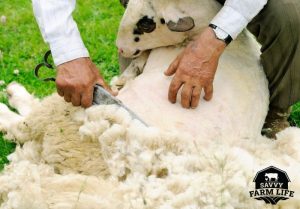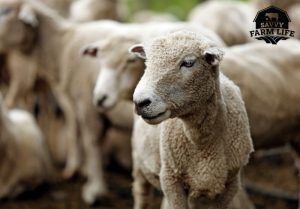
What You Should Know Before Shearing Your Sheep
Sheep produce wool, the product that we use for clothing, carpeting, and even mattresses. Wool is a soft, warm, and even fire-retardant product that has many purposes. The procedure used to remove the wool from the sheep is called shearing, and is usually done annually in the Spring. As you likely purchase and consume products containing wool, you may be wondering if the sheep are hurt during the shearing process.
Does shearing hurt sheep? If done correctly, shearing does not cause pain to the sheep, and in fact offers many health benefits including parasite control and reduction of heat stress. While shearing does not cause physical pain, it does cause stress to the animal, and should be done with care.
If you plan on owning wool sheep, shearing is routine maintenance that must be done in order to maintain hygiene. To learn more about shearing sheep and the effects it has, read on!
How Shearing Can Be Dangerous to Sheep
While shearing in itself is not painful to sheep, a sheep will of course experience pain if an injury occurs. Injury during shearing is more likely with very frightened animals, and inexperienced shearers. For this reason we recommend doing your research and watching the professionals before you take a stab at the process yourself.
Sheep tend to have skin folds around their buttocks and shoulders. While shearing these areas, you will want to use your free hand to gently pull on the skin so that it is taut – this will help you to shear without creating lacerations as you move over the skin folds. Also, take into account the teats when shearing your ewes – you can cover the teats with your free hand or ask someone else to so that you don’t shear over them and cause injury.
Shearing Is Stressful To Sheep
While shearing does not cause physical pain if done correctly, it does cause stress to sheep. Sheep are notoriously timid and do not like being handled. The act of catching, penning, and handling the animal is all very frightening for a sheep.
A study done in the 90’s by the University of Western Australia focused on how different acts of sheep handling affected 30 Merino wethers. The researchers subjected the sheep to shearing, using blood samples to measure the cortisol levels of the sheep, which indicates physiological stress. Sheep that were sheared showed significantly higher levels of this cortisol than did their counterparts who were not subjected to shearing. They found that shearing produced the most physiological stress of all of the activities they performed with the sheep – including drafting, crutching, dipping, and drenching.
How To Minimize Stress During Shearing
Stress can be harmful to sheep, and so you will want to do what you can to minimize the stress your sheep feel during shearing. Sheep have very long memories, and so you will want to make the process as peaceful as you can – the rougher you are, the more your sheep will fight the process in the future.
Corral your sheep the day before the shearing. Corralling will be stressful in itself, and by doing this the day before, you can allow the sheep to calm down before the process of shearing. Make sure that you have all of your equipment gathered and ready before you bring the first sheep in. The quicker the process for the sheep, the less they will fight you. Speak calmly to your sheep, and be firm but gentle as you handle her. Try to avoid loud noises, barking dogs, and other chaos.
Your goal here is to minimize stress, not eliminate it. You could light candles, play soft music, and dim the lights while you shear – and your sheep will still be stressed out (actually, we recommend against dimming the lights – you want to be able to see what you are doing). Fortunately, the stress will not last forever. In the Australian study performed on the Merino sheep, the researchers continued to measure the cortisol level of the shorn sheep. They discovered that about 90 minutes after the shearing was complete, the cortisol levels returned to baseline.
Why Sheep Need to Be Sheared
While there are also sheep that have normal hair like a goat, sheep with wool must be sheared on a regular basis for health reasons. Here’s what you need to know:
Wool Grows Continuously
 Shearing is necessary for most wool-producing sheep. Wool will continue to grow no matter how long and heavy it gets. If a sheep is left unshorn, its wool will become matted and the sheep may even be unable to move. This causes discomfort to the animal, and is also a safety concern – if a sheep is slower because of her extra wool, or is unable to see because of the wool growth around her face, she will be less likely to see a predator or other looming threat.
Shearing is necessary for most wool-producing sheep. Wool will continue to grow no matter how long and heavy it gets. If a sheep is left unshorn, its wool will become matted and the sheep may even be unable to move. This causes discomfort to the animal, and is also a safety concern – if a sheep is slower because of her extra wool, or is unable to see because of the wool growth around her face, she will be less likely to see a predator or other looming threat.
Did you know that a too much wool on a sheep can cause the sheep to fall down and get stuck!? To learn more, visit my article Sheep Falling Over: Causes, Prevention, & Tips.
Thick Wool Can Cause Heat Stress in Sheep
Most of us use wool products during the Winter months to keep us warm – from warm wool socks, to wool-insulated jackets. We don’t want to wear these socks and jackets in the heat of Summer – and neither does your sheep. A sheep carrying around a full fleece will be more likely to succumb to heat stress, as she will be unable to adequately cool herself down. It is important that you consider the elements when it comes to shearing your sheep – make sure to shear them at an appropriate time so that they are not uncomfortable during the Summer. The most popular time for shearing is the Spring.
Shearing Helps With Parasite Control and Skin Conditions
Shearing can also help to prevent infestations of parasites. Wool has a habit of collecting all kinds of debri – from sticks and leaves to fecal matter and urine. Parasites love these collections, and will be attracted to a sheep’s dirty wool. Shearing regularly helps to control these parasites.
Thick wool can also trap moisture and waste to your sheep’s skin. This can cause skin to become irritated and itchy. By shearing your sheep, you provide them with relief from the bacteria that is otherwise held to their skin. If you notice that your sheep is incredibly itchy or uncomfortable, shearing may help to relieve the problem.
How To Shear Sheep
Many shepherds call in professional shearers to shear their sheep each year, but you can also choose to perform the chore yourself.
Make Sure You Have to Right Equipment
If you would like to learn how to shear your own sheep, you will first need the right equipment. You can purchase electric clippers made for this purpose from your local feed store, or even online. Don’t buy the cheapest clippers you can find – the more teeth in the comb, the better shear you will get, which will make the process easier and quicker.
Set Up a Sheep Corral For Shearing
It will be helpful to have an extra set of hands, and you will want to corral the sheep the day before you plan on shearing. There will be several positions you will need to move the sheep into so that you can shear all of the wool – several tutorials can be found online, and it would be helpful to watch a couple of videos. Inexperience and hesitancy can cause additional stress and even increase the potential for injury, so it may also be beneficial to hire a professional the first time so that you can watch the process up close and in person.
When To Shear Sheep
When to shear your sheep is an important decision. Wool is your sheep’s natural defense against the cold elements, and if you leave your sheep without adequate protection you will risk causing winter cold stress to your sheep. In most climates, it is customary to shear your sheep in the late Spring / early Summer – and before lambing. If you are expecting lambs in the late Spring, go ahead and shear a month or so before that. This will ensure a cleaner environment for the lamb and will reduce the chance of parasitic infection or other complications.
Sheep Breeds That Do Not Require Shearing
If this is all sounding a little overwhelming to you, know that there are breeds of sheep that do not require shearing at all – you may choose to raise these sheep for weed control, meat, or even milk instead of for their wool.
There are several breeds of “hair sheep”. Hair sheep do not have wool, and instead have hair similar to that of a deer’s hair. This hair sheds naturally, and needs no intervention from humans. Popular breeds of hair sheep include the Katahdin, Barbados Blackbelly, American Blackbelly, St. Croix, Blackhead Persian, Red Maasai, and Romanov.
In addition to hair sheep, there are a few breeds that have a combination of hair and wool. These sheep also shed their coats without intervention, though most coats from these breeds cannot be spun and used. Breeds with a wool/hair combination include the Dorper, the Wiltshire Horn, and the California Red.
Shearing: A Necessary Stressor
While no one wants to cause stress to their sheep, it is a necessary practice if you have wool-producing sheep, and is ultimately beneficial to your sheep’s health and comfort (don’t expect them to thank you for it, though).
While shearing can be difficult, wool sheep is just one way you can draw revenue for you sheep. To learn more about ways you can make money off of sheep, visit my article What Do Sheep Produce? Ultimate Guide.
